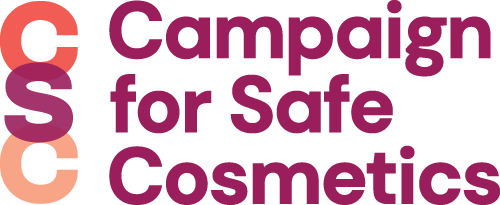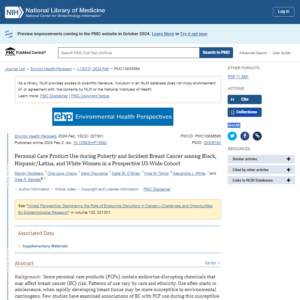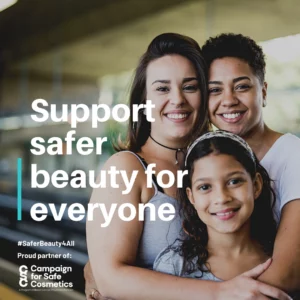For Immediate Release: January 15th, 2014
SAN FRANCISCO—Exposure to certain toxic phthalates has substantially decreased in the American population according to a study led by researchers at UC San Francisco and published today in the journal Environmental Health Perspectives. Study authors suggest that the decrease may be due to a federal ban on phthalates in toys, as well as cosmetics companies moving away from the use of these chemicals in response to advocacy efforts led by the Campaign for Safe Cosmetics. Levels of some “regrettable substitution” phthalates are on the rise, however, including one that was recently added to California’s Proposition 65 list of chemicals known to cause cancer, birth defects or reproductive toxicity.
“Kudos to the millions of conscientious consumers whose concerns about phthalates in kids’ toys and cosmetics are now being credited with helping to decrease the levels of phthalates in people,” said Janet Nudelman, policy director at the Breast Cancer Fund and co-founder of the Campaign for Safe Cosmetics, which was established in 2004 out of concerns about the presence of phthalates in personal care products.
Phthalates are industrial chemicals, which soften plastics that are used to make common consumer products including fragrances, cosmetics, plastics, and building materials. Phthalates are endocrine-disrupting chemicals; exposure has been linked to early puberty, a risk factor for later-life breast cancer; reproductive harm in males; DNA damage to sperm and decreased sperm counts; and asthma.
Due to their ubiquity in common consumer products and potential to harm reproduction, phthalates have long been a target of state and federal legislative and market-based advocacy campaigns. In 2008, the Breast Cancer Fund led a national campaign that resulted in a Congressional ban on six phthalates in children’s toys. The law permanently banned three phthalates: DEHP, DnBP (also abbreviated as DBP) and BBzP. According to the study, the levels of all three have gone down in people. Three other phthalates—DnOP, DiDP, and DiNP—were provisionally banned pending further study. Exposures to these phthalates have increased. Of particular note is exposure to DiNP, which increased nearly 150 percent. DiNP, which was recently added to California’s Proposition 65 list of carcinogens, is widely used to replace DEHP in plastics.
“Trading one toxic chemical for another in an endless and costly parade of regrettable substitutions is unacceptable,” said Cindy Luppi of Clean Water Action, a co-founder of the Campaign for Safe Cosmetics. “It’s time for strong laws and corporate policies that make safe products the industry standard.”
Consumer pressure has led more than 1,000 cosmetics and personal care companies to remove some dangerous chemicals, including phthalates, from their products. A 2008 report by the Campaign for Safe Cosmetics found a marked decline in the use of DEHP and DnBP by the cosmetics industry, compared to the findings of a 2002 Campaign study, which reported 72 percent of shampoos, deodorants, fragrances and other products contained these and other phthalates. Not surprisingly, the study also found a drop in levels of DEHP and DnBP in people.
“Women have historically had higher levels of phthalates in their bodies than men, so the steep decline of certain toxic phthalates in women is a good sign,” said Alexandra Scranton, Director of Science and Research at Women’s Voices for the Earth. “However, we remain concerned that manufacturers may be swapping out high profile toxic phthalates for less well-known phthalates, meaning the potential for harm remains real and more research must be done to protect public health.”
The study, “Temporal Trends in Exposure to Phthalates: Findings from the National Health and Nutrition Examination Survey 2001-2010,” published online today in Environmental Health Perspectives, reports on trends from 2001 to 2010, noting exposure to eight phthalates among 11,000 people who took part in the National Health and Nutrition Examination Survey (NHANES) conducted by the U.S. Centers Disease Control and Prevention.
“We commend the researchers for this excellent study, which reinforces the important role policy and market decisions can have on reducing the levels of unsafe chemicals in people and protecting public health,” said Nudelman. “Our campaigns to encourage companies to make safer products and to convince the government to pass health-protective laws have clearly paid off.”
###
The Campaign for Safe Cosmetics is a national coalition working to make personal care products safe for people and the planet. Find out more at: https://www.safecosmetics.org
Getting Phthalates Out of Cosmetics—A Timeline
2002: The Campaign for Safe Cosmetics’ report Not Too Pretty reveals that a majority of personal care products tested contain phthalates.
2004: EU bans DBP and DEHP from cosmetics.
2004: Estée Lauder removes DBP from its nail polish and notes it does not use DEHP.
2005: The Breast Cancer Fund co-sponsors first legislation (Calif. bill AB908) to ban DBP and DEHP from cosmetics. The bill does not pass.
2005: The California Safe Cosmetics Act, co-sponsored by the Breast Cancer Fund, becomes law, requiring manufacturers to disclose use of carcinogens and reproductive toxicants, including phthalates.
2005: L’Oréal and Revlon state to the Campaign that they do not use DBP or DEHP.
2005: Unilever states to the Campaign that it does not use DEP and will stop using DBP and DEHP.
2005: Avon announces it will no longer use DEP.
2005: Top nail polish brand Orly International stops using DBP.
2006: Top nail polish brands OPI and Sally Hansen stop using DBP.
2008: The Campaign’s report A Little Prettier finds much of the cosmetics industry has stopped using DBP and DEHP but is still widely using DEP.
2009: L’Oréal reports it will stop using DEP by 2010.
2010: The Campaign’s report Not So Sexy finds the cosmetics industry has made considerable progress in removing DEHP and DBP from fragrance, but is now primarily relying on DEP, which is detected in 12 of the 17 fragrances tested.
2011: Johnson & Johnson states to the Campaign that it does not use any phthalates in its baby products.
2012: Johnson & Johnson announces it will eliminate DEP from all adult products by 2015 and that it does not use any other phthalates.
2012: L’Oréal states to the Campaign that it does not use any phthalates.
2013: Procter & Gamble commits to removing DEP from all products by 2014.
Getting Phthalates Out of Toys—A Timeline
2005: California state legislature considers first bill to ban phthalates in toys (AB 319). The Breast Cancer Fund testifies in support of this bill, which fails to gain passage.
2006: San Francisco becomes first municipality to pass a ban on six phthalates in toys. The Breast Cancer Fund provides testimony and technical support to the city in support of the ban.
2007: After successful campaigning by a coalition of parents, environmental groups and public health organizations led by the Breast Cancer Fund and Environment California, California state legislature passes ban on six phthalates in toys (AB 1108).
2008: The Breast Cancer Fund works closely with advocates in Washington and Vermont to pass similar legislation.
2008: The Breast Cancer Fund leads a national coalition to win passage of a federal ban on six phthalates in toys as part of the Consumer Safety Protection Improvement Act. DEHP, DBP and BBP are permanently banned; DINP, DIDP, DnOP are provisionally banned. The bill is signed into law by President George W. Bush.
Phthalates on California’s Proposition 65 List
1988: DEHP listed as a cancer endpoint
2003: DEHP listed as a developmental toxicant
2005: BBP and DBP listed as developmental toxicants
2007: DIDP listed as a developmental toxicant
2013: DINP listed as a cancer endpoint
Note: DBP is also abbreviated as DnBP















